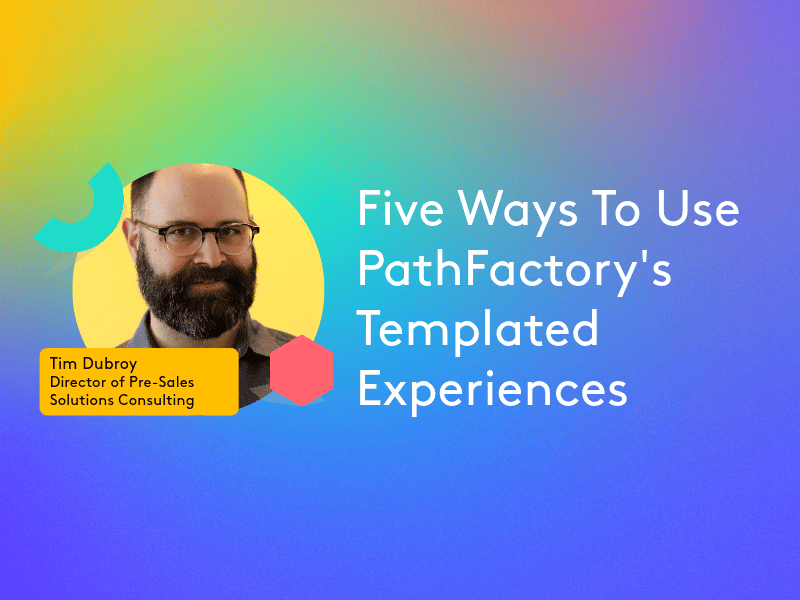
PathFactory Makes ABM Easy With Templated Experiences
PathFactory’s Director of Pre-Sales Solutions Consulting Tim Dubroy shares how go-to-market teams can use Templated Experiences to drive content engagement.
I know what you are thinking, a top-X number list? I didn’t think I was reading The Huffington Post! Well… Hi. My name is Tim and I am a nerd who works on the Pre-Sales Solutions Team here at PathFactory, and I can demo PathFactory all day, but I don’t know how to write blog posts.
So what do you get when a non-copywriter offers to do some writing? A lowest common denominator click-bait list post! Yay!
The idea for this post came from seeing the cool things our beta customers were doing when helping us test our now available “Templated Experiences” feature, built to help marketers scale compelling, beautifully designed, personalized web experiences for (initially) ABM use-cases. Our customers wanted a way to combine our PathFactory’s tried-and-true bingeable Target and Recommend Content Tracks with no-code, customizable, microsite-style, dynamically personalized templates. Things quickly went beyond ABM, so let’s get to the list!
1. In-Person Event (Booth) Product Guided Tours
We took this idea and ran with it at the recent 2023 Forrester Summit. The idea is you use a branded template and build out a special site for your booth staff to use to demo your product. It can house links to presentation files and special videos or assets, or how we used it, as a “use-case library”. In our case we put a core set of strategies or use-cases that apply almost uniformly to almost any marketer, and those strategies became links in the navigation and on the homepage. So if a booth visitor says “yeah, I am in fact looking for something to help my partner team create engaging experiences without burdening the web team” anyone at the booth simply has to click “Partner Enablement” to see the purpose-built examples.
2. Partner Enablement
Here is an example of a page our Head of Strategic Partnerships created to detail how we work with 6Sense, one of PathFactory’s most important relationships. The logos are easily swappable, the tiles that promote assets or link to documentation are quickly changed, the imagery is mostly stock brand assets, and the “Meet your Team” section really doesn’t change. This makes creating promotional pages fast and easy for the next partnership announcement. This allows small partner teams to be nimble.
3. Post-Webinar Content Hub
Forget just sending the slides and a recording of a webinar. Send visitors to a templated experience built around the theme of the webinar. Include call-out stats, ongoing results of in-webinar polls, speaker profile pages or links to LinkedIn, and obviously the slides and the recording in a Content Track. Basically this supercharges a webinar or webinar series so it becomes a sort of thematic forever destination that you can send traffic to well after the event is over. It is also a great way to help a guest speaker promote an event when they can send their audience to a fully realized destination instead of just a sign up form. And of course the webinar series Templated Experience does come with a permanent sign up form, but it’s surrounded by great compelling content.
4. “White Glove” Customer Resource Center
Most SaaS companies have a fairly robust support portal or help area. Many also use learning management solutions (LMS) for training and onboarding. But what about building a microsite for each customer where the CSM can cherry-pick just the most relevant documentation, assets, videos, and even include notes, and build a special set of pages just to speak to the needs of that new customer, and then evolve it over time? Easily add personal touches like logos, fun GIFs from inside jokes, or store meeting recordings for when folks can’t make that cadence call? Do all of this without the web team’s help, and really make implementation a standout experience. Also, when a new CSM comes onto the account, there will be a nice tidy site they can use to understand the key aspects of the account, along with a place to continue adding new content where the customer is used to finding it.
5. ABM
Scale is the #1 issue surrounding a mature ABM program. Speaking in a personalized manner to an ever-growing list of target accounts becomes a bit of a nightmare to manage if you can’t spin up really slick, purpose-built, content experiences easily. This is why we built Templated Experiences, easily letting a marketer select a theme, edit key images and copy, add a relevant multi-asset Content Track, but have all the key brand elements locked down and impossible to break. Best of all possible worlds!
Here is an example of a templated experience that looks 1:1 on the surface, but the account name has been dynamically inserted (note, VisionScale is a fake company we created for demos) and the content is industry specific. Therefore you can route clicks (using 6Sense, Demandbase, or even PathFactory’s Segments & Routes feature) based on industry, and the page is automagically relevant! The “Learn More” button launches a Content Track in overlay allowing you to include multiple relevant assets all in one place vs. the traditional one-landing page + one form = one asset formula. I built that one in about 10 minutes because I did it from scratch from a theme instead of cloning an existing experience and just swapping a few things.
These are just a few of the great ideas our customers have given us when we provided access to an easy-to-use and flexible way to generate templated experiences. Stay tuned for more as we just launched Templated Experiences and expect many more fun examples soon!
